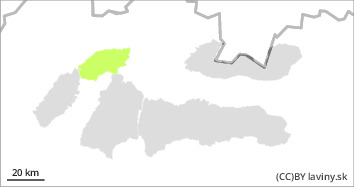
Danger level
 |
|  |  | |||||
|  |
|  |

Watch out for wet snow!
In the High, Western and Low Tatras there is a moderate avalanche danger (i.e. 2nd degree of the 5-part international scale). On very steep slopes, spontaneous or mechanically released avalanches from wet snow can be expected. The danger is particularly high with large additional loads. On slopes with grassy ground, in all orientations, there is a risk of foundation avalanches, which can reach large dimensions. Beware, flowing avalanches have a high destructive potential, even when they are slow!
Snowpack
The snow cover is soaked in the whole profile at altitudes up to 2 200 m above sea level. Strong south wind bringing very warm air does not allow the air temperature to drop below 0°C even at the highest altitudes of the High Tatras even during the night. Beware, the snow is wet and heavy in a thick layer, even a slide from under your own skis or snowboard can pull you down.
Tendency
Enduring.
Compiled by: Ivan Chlebovec



